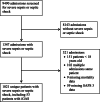Morbidity and mortality in critically ill patients with invasive group A streptococcus infection: an observational study
- PMID: 32505194
- PMCID: PMC7275847
- DOI: 10.1186/s13054-020-03008-z
Morbidity and mortality in critically ill patients with invasive group A streptococcus infection: an observational study
Abstract
Background: Group A streptococci (GAS) are known to cause serious invasive infections, but little is known about outcomes when patients with these infections are admitted to intensive care. We wanted to describe critically ill patients with severe sepsis or septic shock due to invasive GAS (iGAS) and compare them with other patients with severe sepsis or septic shock.
Methods: Adult patients admitted to a general intensive care unit (ICU) in Sweden (2007-2019) were screened for severe sepsis or septic shock according to Sepsis 2 definition. Individuals with iGAS infection were identified. The outcome variables were mortality, days alive and free of vasopressors and invasive mechanical ventilation, maximum acute kidney injury score for creatinine, use of continuous renal replacement therapy and maximum Sequential Organ Failure Assessment score during the ICU stay. Age, Simplified Acute Physiology Score (SAPS 3) and iGAS were used as independent, explanatory variables in regression analysis. Cox regression was used for survival analyses.
Results: iGAS was identified in 53 of 1021 (5.2%) patients. Patients with iGAS presented a lower median SAPS 3 score (62 [56-72]) vs 71 [61-81]), p < 0.001), had a higher frequency of cardiovascular cause of admission to the ICU (38 [72%] vs 145 [15%], p < 0.001) and had a higher median creatinine score (173 [100-311] vs 133 [86-208] μmol/L, p < 0.019). Of the GAS isolates, 50% were serotyped emm1/T1 and this group showed signs of more pronounced circulatory and renal failure than patients with non-emm1/T1 (p = 0.036 and p = 0.007, respectively). After correction for severity of illness (SAPS 3) and age, iGAS infection was associated with lower mortality risk (95% confidence interval (CI) of hazard ratio (HR) 0.204-0.746, p < 0.001). Morbidity analyses demonstrated that iGAS patients were more likely to develop renal failure.
Conclusion: Critically ill patients with iGAS infection had a lower mortality risk but a higher degree of renal failure compared to similarly ill sepsis patients. emm1/T1 was found to be the most dominant serotype, and patients with emm1/T1 demonstrated more circulatory and renal failure than patients with other serotypes of iGAS.
Keywords: Group A streptococcus; Intensive care unit; Sepsis; emm1/T1-type.
Conflict of interest statement
The authors declare that they have no competing interests.
Figures


Comment in
-
The prognosis of critically ill patients with invasive group A streptococcus infection.Crit Care. 2020 Jul 14;24(1):437. doi: 10.1186/s13054-020-03167-z. Crit Care. 2020. PMID: 32665008 Free PMC article. No abstract available.
-
Patients with emm1/T1 serotype invasive group A streptococci infections demonstrated more renal failure than patients with other serotypes: perhaps we should consider some confounders.Crit Care. 2020 Jul 29;24(1):473. doi: 10.1186/s13054-020-03180-2. Crit Care. 2020. PMID: 32727541 Free PMC article. No abstract available.
References
Publication types
MeSH terms
Grants and funding
LinkOut - more resources
Full Text Sources
Medical

